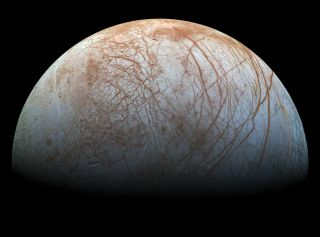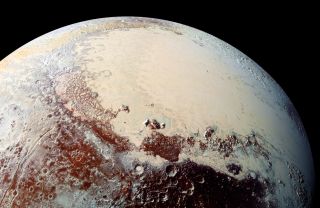Folks , scientists believe the best chance of finding alien life forms beyond Earth is in the sub-surface oceans of other worlds !
Alien-life hunters are eyeing icy ocean moons Europa and Enceladus
By Mike Wall February 25, 2020
The late 2030s are a realistic launch target for an alien-ocean explorer, should NASA choose to develop one.

Jupiter's moon Europa, imaged here by NASA's Galileo spacecraft, harbors a huge ocean beneath its icy shell.
(Image: © NASA/JPL-Caltech/SETI Institute)
As the hunt for life on Mars starts getting into full swing, some scientists are already looking beyond the Red Planet, to our solar system's next astrobiological frontier.
Two rovers are scheduled to launch toward the Red Planet this summer: NASA's Mars 2020 vehicle and Rosalind Franklin, a joint effort of the European and Russian space agencies. Both six-wheeled robots will search for signs of ancient Mars life, and NASA's craft will also collect and cache promising samples for eventual return to Earth, with an arrival here perhaps occurring as early as 2031.
These missions follow on the heels of a lengthy, NASA-led "follow the water" campaign, which has established that Mars was a relatively warm and wet world billions of years ago, complete with rivers, lakes and even, some researchers believe, a big ocean.
Related: Ancient Mars could have supported life (photos)
The Martian surface is dry today (with a few possible seasonal exceptions), explaining the two rovers' focus on finding microfossils and other possible biosignatures from the ancient past. But there are still huge amounts of liquid water in the outer solar system, sloshing beneath the ice shells of multiple moons. The two most intriguing are the Saturn satellite Enceladus and the Jupiter moon Europa, both of whose subsurface oceans are likely in contact with their rocky cores, making possible a variety of complex chemical reactions.
There's a very real chance that tiny creatures are swimming around in the dark, frigid seas of Enceladus and Europa today, many scientists believe. And momentum is building to go out there and look for that possible life in a variety of ways — ideally, by getting life-hunting robots into one or both of those buried oceans.
"It's the ultimate climax of 'follow the water,'" Emily Klonicki, a planetary protection engineer at NASA's Jet Propulsion Laboratory (JPL) in Pasadena, California, told Space.com in December, during the annual fall meeting of the American Geophysical Union (AGU) in San Francisco.
Going to Europa
NASA already has a mission to Europa in the works: a probe called Europa Clipper, which is scheduled to launch in the mid-2020s. After arriving in orbit around Jupiter, Clipper will make dozens of flybys of Europa, characterizing the moon's ocean and studying its icy surface in detail, among other tasks. (The European Space Agency's Jupiter Icy Moons Explorer mission, or JUICE, will also study Europa, along with fellow moons Callisto and Ganymede and the planet itself. JUICE, a Jupiter orbiter, is scheduled to launch in 2022.)
The surface reconnaissance will help pave the way for a future Europa lander, which Congress has directed NASA to develop. The lander — just a concept at the moment, not a full-fledged mission — would dig down and hunt for signs of life about 4 inches (10 centimeters) beneath the European surface. Any biomolecules at such depths would be shielded from damaging radiation by overlying ice, NASA officials have said. (Europa lies within Jupiter's radiation belt, so the moon's frigid surface gets hammered by fast-moving charged particles.)
The ultimate source of most such biomolecules would likely be Europa's vast ocean, which is thought to harbor about twice as much water as all of Earth's seas combined. So, Klonicki and other like-minded researchers would love to get a life-hunting robot down into that alien environment — perhaps a swimming "squidbot" or one that rolls along the ocean's ice ceiling.
This will not be easy, for Europa's ice shell is a formidable barrier: Scientists think the shell is probably between 9 miles and 16 miles (15 to 25 kilometers) thick, so a Europa ocean mission would have to tote quite a powerful drill.
NASA is already trying to spur the development of such advanced tech via a program called SESAME (Scientific Exploration Subsurface Access Mechanism for Europa). SESAME ultimately envisions a nuclear-powered "penetration system" capable of getting 9 miles down within three years of operation. This drill, whose weight is capped at 440 lbs. (200 kilograms), would be delivered to the Europan surface by a lander, which would also provide a communications relay between the digger and Earth. (There may well be life-hosting lakes suspended within the ice shell that such tech could access, but the ocean would be the main target.)
SESAME recently started supporting work being done by groups at JPL, the Georgia Institute of Technology, Johns Hopkins University and the companies Stone Aerospace and Honeybee Robotics. These teams are working on penetrator designs or other aspects of the larger system.
Johns Hopkins' proposal, for example, centers on penetrator-lander communications strategies. And New York-based Honeybee is developing a hybrid drill system called SLUSH (Search for Life Using Submersible Heated), which uses both thermal and mechanical means to slice through ice.
"SLUSH utilizes a mechanical drill to break the formation, and partially melts the fragments to enable the efficient transport of material behind the probe," Honeybee representatives wrote in a description of SLUSH. "The resulting slush behaves like liquid despite being partially frozen, enabling a significant reduction of the power required for melting the full volume of ice."
Heat is both a friend and enemy of the Europa drill designer, said Kris Zacny, director of Honeybee's Exploration Technology Group.
"The big issue is thermal," Zacny told Space.com at AGU, where he and other Honeybee personnel presented work on the company's various drill tech. "The drill heats up too much if you don't dump the heat somehow."
There are other potential difficulties as well. For instance, communications between the drill and lander might be tough to do via a tether once the drill gets deep enough down. Europa's ice shell is a dynamic environment — many researchers think a form of ice-based plate tectonics is active there — so a miles-long tether may well get sheared or snapped. Researchers are therefore investigating the possibility of deploying puck-like modems behind the drill as it descends, Tom Cwik of JPL noted in an AGU presentation.
Furthermore, sterilizing the penetrator and ocean-exploring robot will be of prime importance, to minimize the chances that the mission contaminates a habitable — and possibly inhabited — environment with microbes from Earth. And such sterilization will be tough to achieve, given the complexity of the hardware. (Tough, but not impossible, Klonicki stressed; this aspect of the concept mission is not a showstopper, she said.)
And the overall difficulty of a potential Europa ocean mission is a sort of meta-hurdle in itself, said Sam Howell, a SESAME co-investigator based at JPL.
"Our biggest challenge to getting a probe into the ocean is the laugh-test risk," Howell told Space.com at AGU.
Howell said that most of the important required penetrator technologies probably won't be ready to fly for at least another 10 to 15 years. That would make the late 2030s a realistic launch target for a Europa ocean mission, should NASA decide to develop one, Klonicki said. And there are reasons to be optimistic in this regard, she added, citing the selection of the Dragonfly drone mission to Saturn's huge moon Titan as evidence of the agency's willingness to take risks. (Titan also appears to harbor a buried ocean of liquid water, by the way. The huge moon sports hydrocarbon seas on its surface as well.)
And the risks inherent to a Europa ocean mission would definitely be worth taking, Howell said, describing such a project as "almost an obligation."
"We could own the search for life," he said.
Enceladus, too
Some of these exploration strategies could be employed at Enceladus as well, though the Saturn moon's ocean may be significantly more accessible than that of Europa.
A number of big "tiger stripe" fissures score Enceladus' south polar region, and dozens of geysers blast water ice, organic molecules and other material into space from these cracks. These geysers are powerful and prolific; the plume they create makes up Saturn's E ring.
The geyser material is likely coming from Enceladus' sea, so the tiger stripes could be a portal, potentially allowing a probe to get into the water without drilling through miles of ice. And some scientists and engineers are developing tech that could exploit this convenient loophole.
For example, a group at JPL is working on the Exobiology Extant Life Surveyor (EELS), an autonomous, 13-foot-long (4 meters) snakelike robot that would spiral its way down the tiger stripe cracks until it reached liquid water. A long tether would connect EELS to a surface lander, which would provide power to the ocean explorer, the researchers explained in an AGU presentation.
A recent internal JPL study envisions EELS and the lander as part of a larger overall mission, which would also include a melt probe and an Enceladus orbiter, which would relay data from the surface craft back to Earth.
Related: Photos: Enceladus, Saturn's cold, bright moon
"A single Flagship-level mission that would search for life on Enceladus’ surface, within its ice shell and in the subsurface ocean may be the most comprehensive opportunity for astrobiology in the coming decade," JPL's Jason Hofgartner and his colleagues wrote about this idea in yet another study presented at AGU in December. ("Flagship" is NASA's most expensive mission class. Planetary-exploration flagships, such as the Curiosity Mars rover and Cassini Saturn probe, which discovered Enceladus' tiger stripes, generally have prices over $1 billion.)
Even if NASA doesn't end up approving such a mission, the geysers provide a way to sample the ocean indirectly. Indeed, Cassini flew through Enceladus' plume multiple times, and future life-hunting probes could do the same. (Cassini, whose long, accomplished mission ended in September 2017, wasn't equipped to search for biosignatures.)
Several research groups have proposed Enceladus plume-sampling missions, though NASA has yet to select any for development. And something similar may be possible at Europa, which appears to sport a plume of its own. However, Europa's putative geyser activity seems to be much weaker and more transient than that of Enceladus, whose powerful jets are on all the time.
Europa Clipper team members have said they'll aim to fly through Europa's plume, if such a maneuver is possible. And, even though Clipper is not a life-hunting mission, there's a chance — albeit a very slight one — that the probe could detect biosignatures in the plume material, if the right ones are there to be found, mission scientists have said.
So, stay tuned. If you're a fan of ocean moons, the next few decades could be a lot of fun.
Regards



